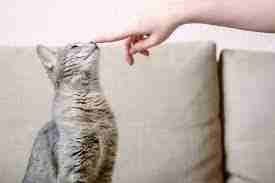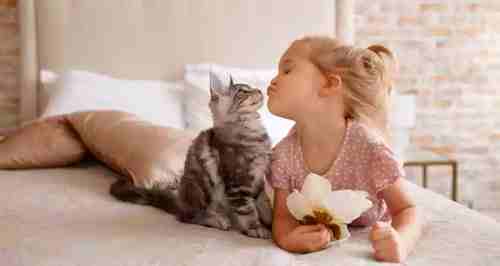Cats can be viewed as intelligent, insecure, or cold. However, all of them aren’t true. You can control a cat’s destructive or destructive behaviors. Cats can be found to jump onto counters, chew at wires, and scratch at household things that aren’t designed to strike. These behaviors can be typical reactions to the cat’s surroundings, while some are bad habits. There are many ways to get cats from engaging in such annoying behaviors, such as clapping hands, yelling, or applying air spray. It’s not recommended to control your pet by hitting it by kicking it in the face, scaring it, or taking it with the scruff of the neck or any other destructive ways.
Allowing a cat to behave in a way that isn’t punished can reinforce the notion that it’s acceptable. However, a way to modify your cat’s behavior is by rewarding good behavior and disciplining for poor behaviors. In order to avoid intending to ruin your relationship with your cat or harming it, it’s crucial to be aware of the best methods to discipline a cat.
The Don’ts of Disciplining Your Cat
Be careful not to compare your cat to the dog you have:
If you’ve trained your own pet, you might think that the process of disciplining your cat is the same as how you handled your dog. Could you not do it? The dogs and the cats are different creatures and aren’t learning in the same manner. Although your dog might engage with keen attention to instructions during the training process, your cat will not listen to your commands to stay and sit. Being aware of the need to engage your cat differently is the first step towards the success of both.
Do not physically discipline your cat:

Pets can be difficult when you’re trying to learn with them. However, it’s no secret that you shouldn’t hurt the cat when disciplining her. Cats tend to be tolerant of methods of punishment used by humans; however, physically dominating a cat can break your bond with your cat. Do not force, shake or strike your pet. Doing this could make the problem more difficult and make her angry or even withdraw.
Additionally, they struggle to link physical punishments with negative behavior. So, it’s not really training them to not do it. If your pet’s training is too hard for you to handle, you should seek reinforcements from friends or a professional trainer. This isn’t a defeat; it’s help!
It would help if you didn’t shout to emphasize your claim:
It’s not like you have the same conversational language as your pet, so don’t believe that your cat will be able to understand you more by raising your voice. Naturally, your cat could be aware that the changes in your voice indicate there’s something different. But screaming could scare your cat or draw focus on negative behavior. The sound of your voice can create a feeling of nervousness and stress that could lead to additional infractions.
Best Way to Discipline a Cat

Are you unsure whether it’s possible to manage a cat’s behavior? It’s all about making your cat associate bad actions with unpleasant consequences. Cats are very intelligent and have the ability to intuitively keep a record of both good and bad memories. If he is caught engaging in poor conduct, you’ll be able to react by making a noise, splash of water, or other means of dissuasion until you’ve discouraged him not to repeat the same behavior.
Utilize a steady, solid tone.
Use a tone you wouldn’t normally use to express your satisfaction with your pet. Try saying “No” or “Stop” loudly each whenever your cat does what he’s not supposed to do. You can say “ouch” if he bites or scratches your skin. Select a word or phrase and repeat it with consistency. Do not shout; however, utilize a tone distinct enough to attract your cat’s attention.
Create some noise.
Make sure you catch your cat’s eye whenever the cat jumps up on counters or chews on your wires by shaking the can filled with coins or tapping loudly. Cats are very sensitive to sound, and loud noises can disturb their bodies enough that they stop whatever they’re doing. If you continue to make noise whenever your cat is acting badly, it will start to link the noise with the behavior and cease repeating the behavior.
Clap Your Hands
Another method for your cat to cease causing trouble is to clap your hands. A sudden, loud sound generated by a repeated clapping of the hands can make a nuisance or unsettling for a cat and cause cats to stop.
Cats can easily be scared as well. The act of clapping your hands together can cause them to jolt. Do this for a few seconds, and they will associate their actions (a violation of the law) with the disturbing sound of the claps.
Spray water
Water squirts that are timed correctly can be a great way to get a cat to behave. If you notice your cat chewing on your furniture or scratching it, then spray the cat with water. Applying the spray right during the undesirable behavior is essential, or your cat can’t recognize the relationship. Spray the water with a backward angle so that the cat won’t realize that the water comes from you.
Use Deterrents
Cats who aren’t interested in connecting with citrus, even their lives. Other cats aren’t a fan of pepper flakes for various reasons. What does that mean for us? We’re at an advantage.
Spray sprays can be purchased commercially to combat these odors available to buy and put in areas where you do not want to view your cat. If your cat enjoys chewing things, you’ll be able to find (harmless) sprays that make the chewing objects taste disgusting.
Do you want to play with Cat Cat?
An unhappy cat can be a danger waiting to unfold. If you don’t play with your cat a lot, you could be the cause of their behavior. If your cat enjoys running through the area, chasing around, and swiping on your legs when you’re walking by and on, it could be that someone does not get enough playtime.
Another instance we believe is worth mentioning is when older cats are prone to licking when they bite. If this occurs typically, it results from fear or anxiety in the cat.
It is possible to correct this behavior by purchasing toys for your cat. Find cat-friendly furniture that can be scratched on and an exercise swing to play with even when you’re not there. Anything that can take some excess energy off of you is appreciated.
Time Out
If the cat is doing wrong, you should give him the chance to be punished. Set aside a space in your house to be your cat’s jail. It’s better to have a bathroom. If they are doing something wrong, you should immediately remove them and then put them in your bathroom for twenty minutes to a half hour.
Use a Spray Bottle
Everyone hates getting treated with water. Even cats. Find a spray bottle, and give the cat water whenever they do wrong. One rule of thumb for this correction method is to keep your cat from knowing that water will come from you.
If they don’t, they’ll be able to associate the sprayed water with you, not the bad behavior of their friends.
How to Train a Cat to Stop Inappropriate Playing or Chewing
If you are playing around with your pet, and they suddenly start to nibble or scratch at you, stop watching them immediately. The cat will be told that this behavior is not acceptable. It is also possible to turn them around in the meantime. If they are inclined to scratch furniture, give them a plaything or something safe to cross.
Rule Out Medical Issues
A medical condition can cause your pet to behave in a way or exhibit disturbing behaviors. The most common instance is when a cat suffers from a UTI, diabetes, or hyperthyroidism, which has a high urgency in the urinary tract due to a condition and cannot access its litterbox on time. It then ends with urination outside of the container. Although many pet owners believe that it’s a behavior problem that requires punishment, the situation will not be cured without proper care.
If your cat is suddenly exhibiting behavior that is troubling, like aggression or timidity for a cat once friendly, urinating uncontrollably in the home, arguing with household pets your cat was accustomed to before, or just being in a manner that seems “off,” it’s a recommended to make an appointment with a veterinarian. Instead of being aggressive or hard, your cat could be affected by an undiagnosed health issue or illness.